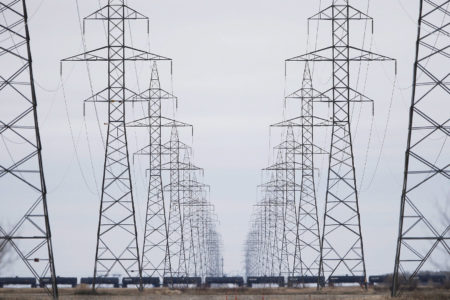
We are 10 years away from 2020, the date when global emissions reduction targets for green-house gases (GHG) are to be met. Regardless of what happened in Copenhagen, or the failure of the US Congress to pass energy legislation this year, or Canada’s slow-moving federal climate change policy, the majority of governments around the world have committed to reduce their carbon emissions by between 15 and 30 percent within a decade. Canada and the US have agreed to 17 percent below 2005 levels by 2020.
Every government also knows that to get from here to 2020 requires a transformation of our energy, industrial and transportation systems. Our capital stock is going to have to change. This kind of transformation will require a wave of innovation and investment that we can hardly comprehend today and that will affect global trade and competitiveness. But we need to shift gears and stop looking at energy, climate change and competitiveness in isolation. These issues go to the heart of our economic recovery. Solutions can be integrated.
But first we need to learn some lessons from watching Barack Obama struggle with these environmental and energy files over the last two years, and, perhaps more importantly, we need to look beyond the dominant political narratives to see what’s happening on the ground, particularly in Canada.
Two years ago, President Barack Obama came into office on a wave of hope and change. American energy security was near the top of his agenda and there was domestic and international expectation that, at long last, climate change policy would move forward. While no one expected President Obama to start with energy, there was an expectation that legislation would be passed within the first two years — and that here in Canada, we would link to any US system.
That isn’t where we are today. Energy legislation is going nowhere in the US Congress until at least sometime into 2011, and the US has not expressed much interest in linking its policies with anyone, including Canada — even if we are a key energy trading partner.
The House of Representatives passed the American Clean Energy and Security Act in June 2009, but Senate legislation has been stalled since then. What’s interesting is that US legislative proposals are always related to energy, jobs and American renewal. This framing allows Congress and Democrats to position their policy proposals as part of a longer-term economic recovery package.
That hasn’t stopped the US administration from committing more than $140 billion for renewable energy, transit systems, clean technologies and trade agreements with countries like China. Where they could act without Congress, they have forged ahead. Even on regulatory proposals, the White House has made it clear that if Congress doesn’t act, then the Environmental Protection Agency will regulate.
But regulations alone will not bring transformative changes. You cannot impose economy-wide regulations to reduce GHGs without a matching set of policies that recognize that capping emissions means that carbon becomes a commodity and, like other commodities, will have a price.
And any price on carbon, however it may be set, is consequential to the price of energy. Every citizen, to a greater or lesser extent, uses energy every day for homes, offices, cars and lighting. Bottom line? While it is possible to announce regulations to reduce GHGs and say you’re done, there are real economic and political consequences to putting a price on carbon.
This begins to explain the wall that American legislative proposals have hit. The US has been proposing variations on an economy-wide cap-and-trade system. In the world of political reductionism, this has meant that Republicans have called Democratic cap-an-trade proposals a “tax on energy” and driven home the fact that jobless Americans can ill afford this additional expense. This is at the heart of the Senate paralysis, and the energy question will be a factor in a surprising number of midterm elections.
Since Canada’s system of climate rules is tied to the US legislation, we are stalled here at home. What are the implications for Canada of moving only in step with developments in the US? Are we being overly cautious or merely pragmatic in recognizing that we can ill afford to deny our economic interdependence in North America? What is our margin for independent action while waiting for developments from our neighbour to the south? One thing is certain. In Canada, our debate is framed in terms of climate change and regulations, while the US is talking about energy security, economic recovery and global competitiveness.
Before we despair, there is growing evidence that many, many innovative initiatives are springing up across the country — and they should be recognized. Governments at all levels, researchers, investors and individuals are looking for solutions, even if it is not the big regulatory fix.
Here in our own backyard Ottawa and the provinces are investing in new technologies and incenting both researchers and entrepreneurs to come up with clean technology solutions. Ottawa is helping these innovators to take these solutions to market faster. Sustainable Development Technology Canada (SDTC) is a government initiative that has leveraged billions of dollars; it is a proven and successful program accountable to government but managed at arm’s length.
Alberta and Ottawa are investing in carbon capture and storage, and energy companies in both the traditional and renewable energy sectors are investing massively to improve their carbon footprints. Municipalities are changing their building codes to enhance energy efficiency and reduce waste while government and industry are changing standards for vehicles and promoting hybrids and electric vehicles.
Obama came into office on a wave of hope and change. American energy security was near the top of his agenda and there was domestic and international expectation that, at long last, climate change policy would move forward. While no one expected President Obama to start with energy, there was an expectation that legislation would be passed within the first two years — and that here in Canada, we would link to any US system. That isn’t where we are today.
On energy transformation, the Energy Policy Institute of Canada and its members are working to develop a broad-based consensus among traditional and renewable businesses as well as Canadian business as a whole to map out a pan-Canadian pathway for the transition of our resource-intensive and energy-rich economy. This approach would include the demand side and lowering the carbon intensity of our energy consumption. The basic operating principle here is that we will meet the economic potential of our energy resources only by being environmentally responsible.
Canadian think tanks have also formed a working alliance to bring their best thinkers and NGOs to advocate for an energy framework that would synergize efforts across this country on the back of our energy and environmental potential. Referred to as the Winnipeg Consensus, they convened a group at the Banff Centre last April of more than 60 diverse stakeholders, who agreed quickly that a Canadian clean energy framework was needed to protect our global competitiveness.
Another example is the Sustainable Prosperity Network. This group brings together academics, economists and public policy experts to identify specific tools that work at the environment-economy interface. This type of pragmatic, research-based analysis can only add to the tools we need to create a greener, stronger economy.
The National Roundtable on the Economy and the Environment has launched a series of studies on “climate prosperity” that offer specific policy prescriptions for Canada and the US to move forward. And the International Institute for Sustainable Development has initiated scientific research on the impacts of global warming and policy analysis on Canada-US energy and the trade implications of border tax adjustment measures in a carbon-constrained world.
A recent study showed for the first time that Canada has more than 400 clean technology companies, with unique strengths in energy efficiency, biofuels, power generation, transportation, water and recycling. These emerging companies are doing their part in the innovation chain but will wither on the vine if policies are not created to encourage their growth.
Our questions should be: How are we supporting the RIMs of the clean tech sector now so that we can have dozens of global clean tech giants in five or ten years? What are we doing to capitalize on our superior energy expertise and decades of energy innovation by Canadian engineers and pioneers? How are we supporting our cities, our farmers, our innovators to make low-carbon, low-consumption systems a reality? Canada has a leadership role to play in shaping the shifting global energy economy, but sometimes we are too obsessed with the negatives of the public relations war on oil sands to see the positives of our energy and environmental expertise. We certainly have solutions to offer but we need public policy debates about those as well.
If you look at the range of initiatives branching from east to west in Canada, there are plenty of actors who are ready to broaden and deepen the conversation to move it toward action and deployment. And that conversation does not need to wait for the US to sort its domestic politics and economic challenges out.
In Europe, a fascinating study released in May seeks to merge investment and economic recovery with action on climate change. The report moves away from a purely regulatory mindset toward something closer to a “climate investment” framework.
Two Swedes — Allan Larsson, a former Swedish minister of finance and director general at the European Commission, and Niclas Ihrén, an expert on sustainability issues — wrote the report, entitled A Climate Investment Framework for the EU: Turning Failure in Copenhagen to Progress in Cancun. It sets out 10 ideas to transform Europe’s economy, reach its energy potential and lower its carbon footprint.
And any price on carbon, however it may be set, is consequential to the price of energy. Every citizen, to a greater or lesser extent, uses energy every day for homes, offices, cars and lighting. Bottom line? While it is possible to announce regulations to reduce GHGs and say you’re done, there are real economic and political consequences to putting a price on carbon.
The study states: “The centrepiece of a Climate Investment Framework is the establishment of a technology neutral CO2 price, free from fossil-fuel subsidies. Such a price can be achieved through the EU Emissions Trading Scheme and nationally based CO2 taxation. A stable price, following a predetermined price trajectory, will provide clear incentives for companies to invest in low-carbon technologies, across industries. This will accelerate the required transformation and strengthen European competitive advantage.”
While we may disagree on the means chosen to reach the objective, we would be ill advised to ignore the goal of a more productive, transformed and competitive, job-creating economy, particularly from a G8 partner where we want expanded trade relationships.
China is taking a similar approach, combining green objectives with industrial policy to make its economy more competitive. While its approach is not perfect, it is making strides designing a post-carbon economy and has the necessary government tools to pass massive investments in transit, energy efficiency, renewable energy and clean production. And judging by the number of trade missions from Canadian provincial governments to China, clearly Canadian companies and some politicians believe that there is an economic opportunity in green technologies.
Companies are making some bold initiatives of their own, seeking to reduce emissions from their products and supply chains. This is not for any altruistic reason but because these projects protect and potentially expand market share and generate economic returns for their shareholders in anticipation of a carbon-constrained world.
So just because government policy and legislation is paralyzed, it doesn’t mean that change agents are sitting still.
With climate change perpetually in the “important but not urgent” quadrant, governments defer action on climate policy and the public doesn’t seem to mind, really. Political leaders are skeptical that citizens are prepared to change behaviour at the scale required, never mind pay the energy premium that a comprehensive climate policy will bring. We like our lifestyle and consider it unfair to be expected to change or redefine our notion of what constitutes success and quality of life.
We have one of the best and richest biocapacities on this planet. We have come out of the recent and lingering economic crisis better than most. We are at a juncture where we can wait for the US to take action or move ahead so that when it does move, we will have gained experience and will have something more to offer.
In Better Together? The Implications of Linking Canada-US Greenhouse Gas Policies, economists Dave Sawyer and Carolyn Fischer suggest that a policy of “go it alone,” with prices on emissions that are similar to those of the US, based on the expectation that a US policy eventually will be in place, would be a lowrisk strategy for Canada. This recent study basically says “Why not?” — especially since there are few risks, and there are advantages for us in forging ahead in a sensible manner.
A recent study showed for the first time that Canada has more than 400 clean techology companies, with unique strengths in energy efficiency, biofuels, power generation, transportation, water and recycling. These emerging companies are doing their part in the innovation chain but will wither on the vine if policies are not created to encourage their growth.
Provinces and states that participate in the WCI (Western Climate Initiative) have been working and experimenting together for several years. They are looking to reduce GHGs, stimulate development of clean energy technologies, create green jobs, increase energy security and independence, and protect public health.
However, it is time for some convergence in Canadian strategies on energy, climate change, competitiveness and economic recovery.
Canada in its own right has significant advantages in terms of both natural resources and the entrepreneurial and innovative capacity of its citizens.
We may need a modern investment framework of our own, integrating outcomes across energy, climate change and competitiveness. This framework would move these debates properly into the economic realm and unleash competitive forces — supported by defined and coordinated government policies — to bring the kind of innovation in the low-carbon field that we have seen revolutionize the information technology sector over the last decade.
It’s not just that political leaders have to be up to the challenge. Voters need to take responsibility for their consumer side too. So far, in both Canada and the US, politicians are betting that the public is not willing to accept the consequences of climate policy that could include using less energy and paying a higher price for the energy used. Political courage will remain in short supply until consumers (voters) show they are willing to accept the costs and potential innovation rewards that putting a price on carbon requires.
We would need two other ingredients to push our political leadership toward early action. The first is to ask for a clear, understandable position on the pros and cons of independent Canadian action while we wait for the US to move. So we could commission some analysis that weighs the benefits of being proactive and the costs of the trade-offs.
The second is more difficult and has to deal with the realities of our system of governance. Much of the energy and environmental responsibilities for action rests with the provinces, and to put forward any plan for action we have to consider their positions and actions to date. Each level of government has leverage and can at least move in a coordinated manner to reinforce many of the initiatives listed in this article.
Governments can also do more to identify areas or sectors where they could collaborate to take actions to meet our environmental responsibilities while positioning our energy potential and markets for sustainable growth.
In Canada, we tend to think of the federal-provincial challenges as insurmountable. It’s up to us to send the signal to political leaders to focus more closely on the innovators and what’s really happening, to partner with willing players and to find areas for collaboration in the interests of both economic prosperity and our natural heritage.
The earliest the US will act on a comprehensive legislative energy package is 2011. In Canada, there is a critical mass of industry, governments, entrepreneurs and citizens who stand ready with a bias toward action and outcomes. Comprehensive domestic, North American and international policies may take a while, and a price on carbon may take even longer. But that shouldn’t stop Canadian innovation and ingenuity.
Photo: Shutterstock






